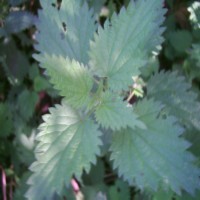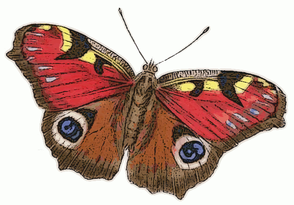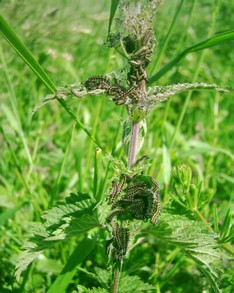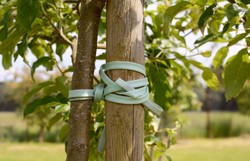Many people think of the common Stinging Nettle (Urtica dioica) as a bothersome weed but it is actually a very valuable plant. It is the food source for the caterpillars of many pretty butterfly species.
In the UK it feeds the larvae of the Small Tortoiseshell, the Peacock, the Red Admiral, the Painted Lady and the Comma butterflies. The first two of these species have caterpillars that can only eat Stinging Nettles.
So if we want to see more of our flying friends around we need to stop killing off the patches of Nettles in fields and waste ground. Butterfly conservation comes down to providing food sources for both the adult insects and the caterpillars.
Many people think all caterpillars just eat leaves but this is not true. The majority of larvae of butterflies and moths too have specific species of plant that they can feed upon. Without the right food-plants they will starve.

Stinging Nettles are good for butterflies and good for you
by BardofEly
Stinging Nettles are a food-plant for many caterpillars and an edible weed that humans can eat too.
Stinging Nettles in the Butterfly Garden
Butterfly conservation
A growing number of people who care about conservation are turning over parts of the gardens to Mother Nature. Butterfly gardening is becoming popular too and this is very important because a very large number of species are declining in numbers, are endangered or even threatened with extinction. Habitat destruction, Climate Change, modern mono-culture farming and the widespread use of herbicides and pesticides are all taking a heavy toll. Butterflies really do need our help!
It is easy to get a patch of Stinging Nettles growing in your back garden or on an allotment if you have one of these. All going well, the mother butterflies will find the plants and lay their eggs on them. When I was living in Ely, Cardiff, I had Red Admirals, Small Tortoiseshell and Painted Lady caterpillars in my garden.
Many moth caterpillars also feed on Stinging Nettle leaves. The curious Snout Moth is one species that has larvae that feed on this plant. It gets its name because of the projection on the front of its head. The large and very flamboyant Garden Tiger Moth with its for-wings painted in chocolate brown and creamy white and back-wings of orange with blue spots, has big furry caterpillars that are known as “Woolly Bears,” and they will eat nettle leaves as well. This pretty moth is sadly declining in numbers in the UK.
Nettles are perennial and will come back year after year after they have died down for the winter. The caterpillars can eat away at them but you won’t have to worry about losing your nettle patch because they are sure to recover.
Best Butterfly Gardening books to buy
 | Gardening for Butterflies: How You Can Attract and Protect Beautiful, Beneficial Insects Timber Press |
 | Butterfly Gardening: The North American Butterfly Association Guide Princeton University Press |
The Stinging Nettle is an edible weed
Eaten like spimach
Stinging Nettles are a wonderful source of vitamins and minerals and will cook like spinach in a small amount of water. Miraculously the stinging properties they posses completely go when cooked. Of course, it is wise to wear gloves when gathering Stinging Nettles, for obvious reasons.
Collect the young shoots and leaves before June, wash them and simmer in water until obviously done. Serve with a know of butter on top. Nettles can also be used in soups and made into an herbal tea or even an ingredient for herb beer.
Richard Mabey in his classic book on foraging for edible plants, with the title Food For Free, not surprisingly has a lot to say about Stinging Nettles and gives it an A rating for usefulness and edibility.
Copyright © 2012 Steve Andrews. All Rights Reserved.
Food For Free by Richard Mabey
A classic book on foraging
 | Food for Free: 50th Anniversary EditionWilliam Collins / |
 | Food For Free (Collins Gem)Collins / Only $7.95 |
 | Food for FreeCollins / Only $8.49 |
Stinging Nettles make Nettle Tea
Gathering and Making Nettle Tea
You might also like
Gardening in Difficult ConditionsSome gardens thrive despite the conditions due to the skill and dedication of...
Weather-proof your gardenIn times of climate change gardeners need to ensure that they have the best p...





 What to see and do in Icod de los Vinoson 06/28/2016
What to see and do in Icod de los Vinoson 06/28/2016
 Herbs of the Sun, Moon and Planets is the follow up to Herbs of the Northern Shamanon 10/03/2015
Herbs of the Sun, Moon and Planets is the follow up to Herbs of the Northern Shamanon 10/03/2015
 Music for Pagan Weddingson 03/07/2013
Music for Pagan Weddingson 03/07/2013
 Los Silos is part of Tenerife’s Low Island or Isla Bajaon 02/23/2013
Los Silos is part of Tenerife’s Low Island or Isla Bajaon 02/23/2013



Comments
Yes, as Jo has posted, it is a very versatile plant and it was used in ancient times. Thanks for commenting!
Nettles were also used for a weaving fiber similar to flax. I'm so sad that it doesn't grow around here.
Yes, it is a very useful plant indeed. Thanks for your feedback, Jo!
I've been watching 'Wartime Farm' on BBC 1. They were using nettles for thatch roofs on makeshift buildings too. Very versatile plant, that's everywhere in Britain!